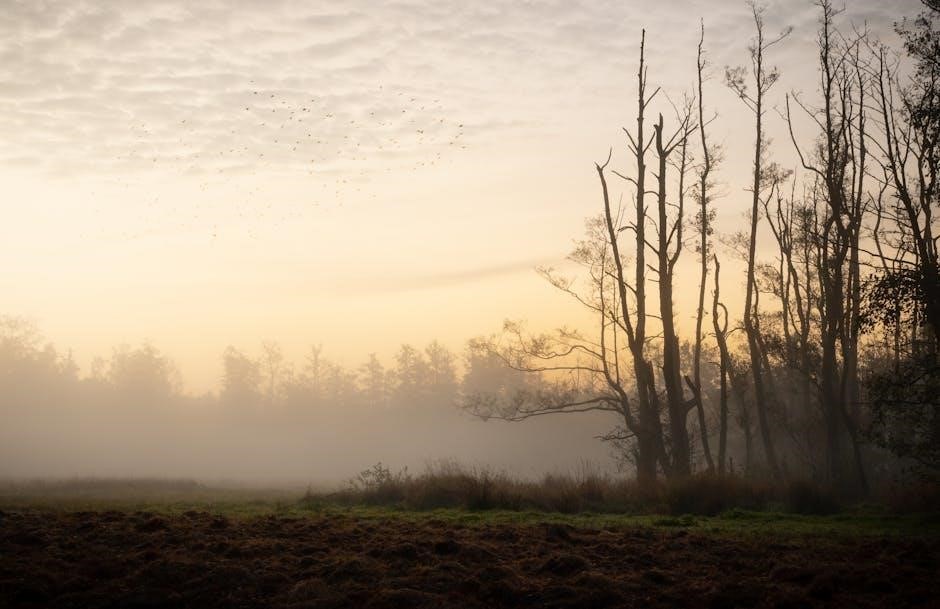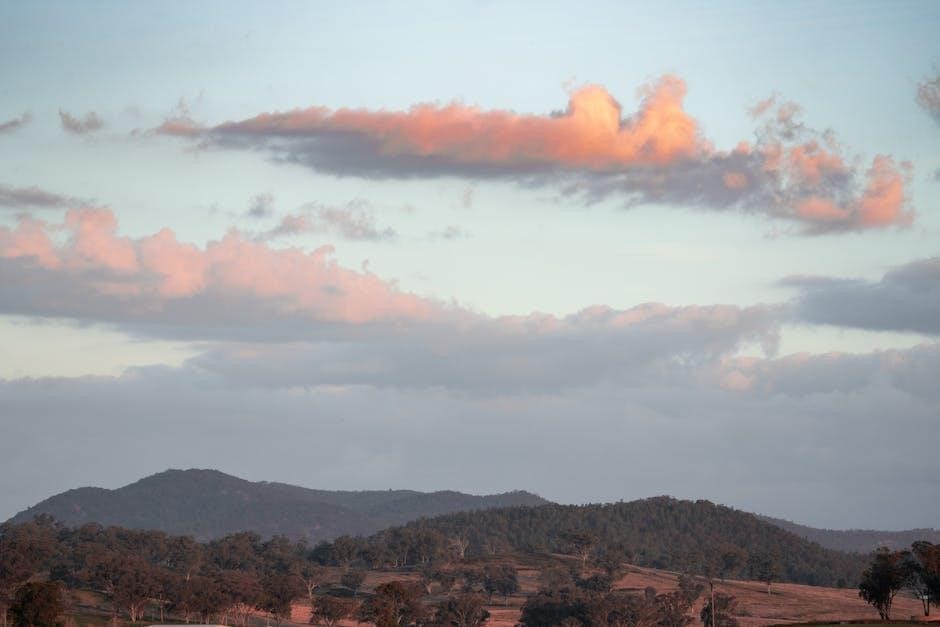Kakadu National Park‚ a UNESCO World Heritage Site‚ spans 20‚000 square kilometers in Australia’s Northern Territory. It is renowned for its rich Indigenous culture‚ diverse wildlife‚ and unique landscapes‚ offering a blend of natural and cultural wonders that attract visitors worldwide.

Overview of Kakadu Knowledge for Tour Guides Program
The Kakadu Knowledge for Tour Guides Program is a comprehensive training initiative designed to equip tour guides with essential knowledge and skills to lead informative and safe tours within Kakadu National Park. Delivered over six months part-time‚ the program is developed by Charles Darwin University‚ Parks Australia‚ and Kakadu National Park. It covers three nationally recognized units from the SIT Tourism‚ Travel‚ and Hospitality Training Package. The course focuses on critical areas such as visitor safety‚ cultural sensitivity‚ and environmental awareness. Participants gain in-depth understanding of Kakadu’s history‚ biodiversity‚ and Indigenous heritage through a mix of theoretical and practical learning. The program is accessible via CD ROM with audio and visual resources‚ ensuring flexibility for guides to study at their own pace. Completion enhances guides’ ability to deliver engaging‚ respectful‚ and safe tours‚ aligning with the park’s conservation and cultural values.

History and Cultural Significance of Kakadu
Kakadu National Park holds profound cultural and historical significance‚ being home to the Bininj/Mungguy people for over 65‚000 years. Its ancient rock art and sacred sites are testaments to this enduring heritage.

Indigenous Heritage and Traditional Owners
Kakadu National Park is deeply rooted in the culture and traditions of its Indigenous custodians‚ the Bininj/Mungguy people‚ who have lived in harmony with the land for over 65‚000 years. The park is home to numerous sacred sites‚ including ancient rock art galleries that depict stories of creation‚ law‚ and daily life. These sites are not only culturally significant but also provide a window into the lives of the region’s first inhabitants. The traditional owners play a vital role in managing the park’s cultural and natural resources‚ ensuring their heritage is preserved for future generations. Their connection to the land is central to Kakadu’s identity‚ making it a place of profound spiritual and historical importance.

UNESCO World Heritage Listing and Its Importance
Kakadu National Park was inscribed as a UNESCO World Heritage Site in 1981‚ recognizing its exceptional cultural and natural values. This designation acknowledges the park’s unique combination of Aboriginal rock art‚ diverse wildlife‚ and pristine landscapes. The UNESCO listing highlights Kakadu’s significance as a living cultural landscape‚ where Indigenous traditions and natural wonders coexist. It emphasizes the importance of preserving both the environment and the cultural heritage of the region. The listing also attracts global attention‚ fostering international cooperation in conservation efforts. By being a World Heritage Site‚ Kakadu gains access to resources and expertise‚ ensuring the protection of its irreplaceable assets for future generations. This recognition underscores the park’s role as a global treasure‚ blending human history and natural beauty in a way that is rare and invaluable.

Environmental and Geographic Features
Kakadu National Park spans 20‚000 square kilometers in Australia’s Northern Territory. It features diverse landscapes‚ including wetlands‚ monsoon rainforests‚ and sandstone cliffs‚ supporting rich biodiversity and unique ecosystems.
Geography and Climate of Kakadu National Park
Kakadu National Park‚ located in the Northern Territory of Australia‚ spans approximately 20‚000 square kilometers. Its diverse geography includes vast wetlands‚ dense monsoon rainforests‚ and rugged sandstone plateaus. The park is drained by the South Alligator‚ East Alligator‚ and Wildman rivers‚ creating a network of waterways that support abundant wildlife. The climate is tropical‚ characterized by two distinct seasons: the dry season‚ which runs from May to October‚ and the wet season‚ from November to April. During the wet season‚ heavy rainfall rejuvenates the landscape‚ while the dry season brings cooler‚ drier conditions. This seasonal variability shapes the park’s ecosystems‚ supporting a wide range of flora and fauna. The unique interplay of landforms and climate makes Kakadu a biodiversity hotspot and a fascinating destination for exploration.
Biodiversity and Unique Wildlife of Kakadu
Kakadu National Park is renowned for its exceptional biodiversity‚ being home to over 2‚000 plant species and a wide variety of wildlife. The park provides a habitat for iconic Australian animals‚ including saltwater crocodiles‚ kangaroos‚ and wallabies. It is also a vital refuge for numerous bird species‚ with over 280 types documented‚ such as the magpie goose and the rainbow bee-eater. The wetlands teem with fish‚ turtles‚ and frogs‚ while the forests harbor rare marsupials like the northern quoll. Kakadu’s unique wildlife is adapted to its tropical climate‚ with many species relying on the seasonal monsoon rains to survive. This rich biodiversity‚ supported by diverse ecosystems‚ makes Kakadu one of Australia’s most biologically significant regions‚ attracting researchers‚ conservationists‚ and tourists alike. The park’s wildlife is a testament to its ecological importance and cultural heritage.

Visitor Safety and Risk Management
Ensuring visitor safety and managing risks are critical in Kakadu National Park. Guides must be well-prepared for emergencies‚ aware of hazards‚ and skilled in navigating the park’s diverse environments.

Safety Guidelines for Tour Guides in Kakadu
Ensuring visitor safety is paramount for tour guides in Kakadu National Park. Guides must conduct thorough risk assessments‚ monitor weather conditions‚ and stay informed about potential hazards like wildlife or extreme temperatures. They should carry first aid kits‚ communication devices‚ and emergency response plans. Visitors must be briefed on park rules‚ such as staying on designated trails and avoiding dangerous areas like crocodile habitats. Guides should also be trained in emergency procedures‚ such as evacuations or first aid for injuries. Regular updates on park conditions and wildlife movements are essential to mitigate risks. Additionally‚ guides must respect cultural sites and ensure visitors do the same‚ maintaining a safe and respectful environment. Proper preparation and adherence to these guidelines help ensure a secure and enjoyable experience for all visitors in Kakadu.
Emergency Preparedness and Response Plans
Tour guides in Kakadu must be well-prepared for emergencies to ensure visitor safety. This includes having emergency response plans tailored to the park’s unique conditions. Guides should carry essential items like first aid kits‚ communication devices‚ and emergency beacons. They must also know the locations of emergency shelters and evacuation routes. Regular drills and updates on potential hazards‚ such as severe weather or wildlife encounters‚ are critical. Guides should maintain clear communication with park authorities and other teams to coordinate responses effectively. In the event of an emergency‚ guides must remain calm‚ assess the situation‚ and implement pre-established protocols. Proper training in first aid‚ emergency communication‚ and evacuation procedures is essential to minimize risks and protect both visitors and staff. These plans ensure a swift and effective response‚ safeguarding everyone’s well-being in Kakadu’s diverse and sometimes challenging environment.

Tour Guiding Skills and Best Practices
Tour guiding in Kakadu requires strong leadership‚ group management‚ and environmental awareness. Guides must enforce safety protocols‚ respect wildlife‚ and maintain eco-friendly practices to preserve the park’s integrity.
Effective Communication Techniques for Guides
Effective communication is crucial for tour guides in Kakadu National Park to ensure memorable and safe experiences for visitors. Guides should use clear‚ concise language and actively listen to guests to address their needs and concerns. Cultural sensitivity is vital when interpreting the park’s Indigenous heritage‚ requiring respect and awareness of traditional customs. Non-verbal cues‚ such as gestures and eye contact‚ enhance engagement‚ while storytelling techniques can bring the park’s history and environment to life. Using visual aids like maps and images can also help convey complex information. Additionally‚ guides should be adaptable‚ adjusting their communication style to cater to diverse audiences‚ including international visitors and those with varying levels of knowledge about the park. By mastering these techniques‚ guides can foster deeper connections between visitors and Kakadu’s unique landscape and culture.
Cultural Sensitivity and Interpretation Techniques
Cultural sensitivity is essential for tour guides in Kakadu National Park‚ as they interact with diverse visitors while sharing the park’s rich Indigenous heritage. Guides must respect and honor the traditions of the park’s traditional owners‚ avoiding stereotypes and ensuring accurate representation of cultural practices. Effective interpretation techniques involve storytelling‚ which brings the park’s history and significance to life. Guides should be mindful of cultural protocols‚ such as seeking permission before discussing sensitive topics or visiting sacred sites. Using respectful language and acknowledging the ongoing connection of Indigenous peoples to the land fosters a deeper understanding and appreciation among visitors. Additionally‚ incorporating visual aids and interactive elements can enhance cultural interpretation‚ making it engaging and accessible for all audiences. By prioritizing cultural sensitivity‚ guides contribute to preserving Kakadu’s heritage while enriching the visitor experience.

Training and Certification for Tour Guides
The Kakadu Knowledge for Tour Guides program is a part-time‚ six-month course covering three competency units from the SIT Tourism‚ Travel‚ and Hospitality Training Package‚ focusing on visitor safety.
Kakadu Knowledge for Tour Guides Course Structure
The Kakadu Knowledge for Tour Guides course is structured as a part-time program lasting six months. It is designed to equip tour guides with essential knowledge and skills to lead safe and informative tours within Kakadu National Park. The curriculum is divided into three key competency units derived from the nationally recognized SIT Tourism‚ Travel‚ and Hospitality Training Package. These units focus on critical areas such as visitor safety‚ cultural sensitivity‚ and environmental awareness. The course combines both theoretical and practical learning‚ with assessments ensuring guides meet high standards. Additionally‚ the program offers flexible learning options‚ including CD ROM materials with audio and visual content‚ allowing guides to study at their own pace. This comprehensive structure ensures guides are well-prepared to deliver engaging and responsible tours in Kakadu’s unique environment.




About the author